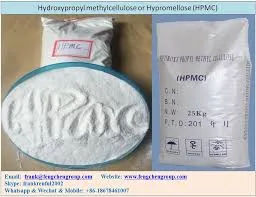
Nov . 01, 2024 18:19 Back to list
Exploration of HPMC Applications in Various Industries and Their Benefits
The Use of Hydroxypropyl Methylcellulose (HPMC) in Various Industries
Hydroxypropyl Methylcellulose (HPMC) is a versatile, semi-synthetic polymer that is derived from cellulose. It has become a significant component in various industries due to its unique properties, including film-forming abilities, water solubility, and its capacity to act as a thickening agent. This article will explore the diverse applications of HPMC and its benefits across several fields, including pharmaceuticals, food, cosmetics, and construction.
The Use of Hydroxypropyl Methylcellulose (HPMC) in Various Industries
The food industry also benefits significantly from HPMC, where it serves as a thickening agent, emulsifier, and stabilizer. It plays a crucial role in the production of gluten-free and low-fat products, improving the texture and mouthfeel without compromising quality. HPMC can help retain moisture in baked goods, enhancing their shelf life and freshness. Additionally, it is used in sauces, dressings, and dairy products, where it helps to achieve the desired consistency and stability, ultimately enhancing the overall consumer experience.
use of hpmc

In the realm of cosmetics and personal care products, HPMC’s thickening and film-forming properties make it a popular ingredient in creams, lotions, and gels. It provides a desirable texture and improves the stability of emulsions. In addition, HPMC can enhance the application of products, allowing for a smooth and even distribution on the skin. Its ability to form a protective barrier also helps in retaining moisture, making it a valuable component in hydrating skin care formulations.
The construction industry uses HPMC as a crucial additive in cement, mortar, and other construction materials. Its water retention properties help in improving the workability of the mixtures, ensuring that they remain workable for extended periods. This is particularly important in hot climates where evaporation can adversely affect curing. HPMC contributes to the mechanical strength and adhesion of building materials, making it an essential ingredient in various construction applications. Additionally, it can improve the consistency and performance of tile adhesives, providing a superior bonding experience.
Furthermore, HPMC is an environmentally friendly substitute that aligns with the growing trend towards sustainability. As industries increasingly seek to reduce their carbon footprint, HPMC presents a renewable alternative for various applications, replacing synthetic materials that may be harmful to the environment.
In conclusion, Hydroxypropyl Methylcellulose is an invaluable compound with a wide array of applications across multiple industries. Its diverse functionalities, including thickening, emulsifying, and film-forming, together with its safety profile and sustainability, make it a sought-after ingredient in pharmaceuticals, food, cosmetics, and construction. As research continues and the demand for environmentally friendly products grows, the role of HPMC in these fields is likely to expand even further, solidifying its importance in modern manufacturing and consumer products.
-
Versatile Hpmc Uses in Different Industries
NewsJun.19,2025
-
Redispersible Powder's Role in Enhancing Durability of Construction Products
NewsJun.19,2025
-
Hydroxyethyl Cellulose Applications Driving Green Industrial Processes
NewsJun.19,2025
-
Exploring Different Redispersible Polymer Powder
NewsJun.19,2025
-
Choosing the Right Mortar Bonding Agent
NewsJun.19,2025
-
Applications and Significance of China Hpmc in Modern Industries
NewsJun.19,2025







